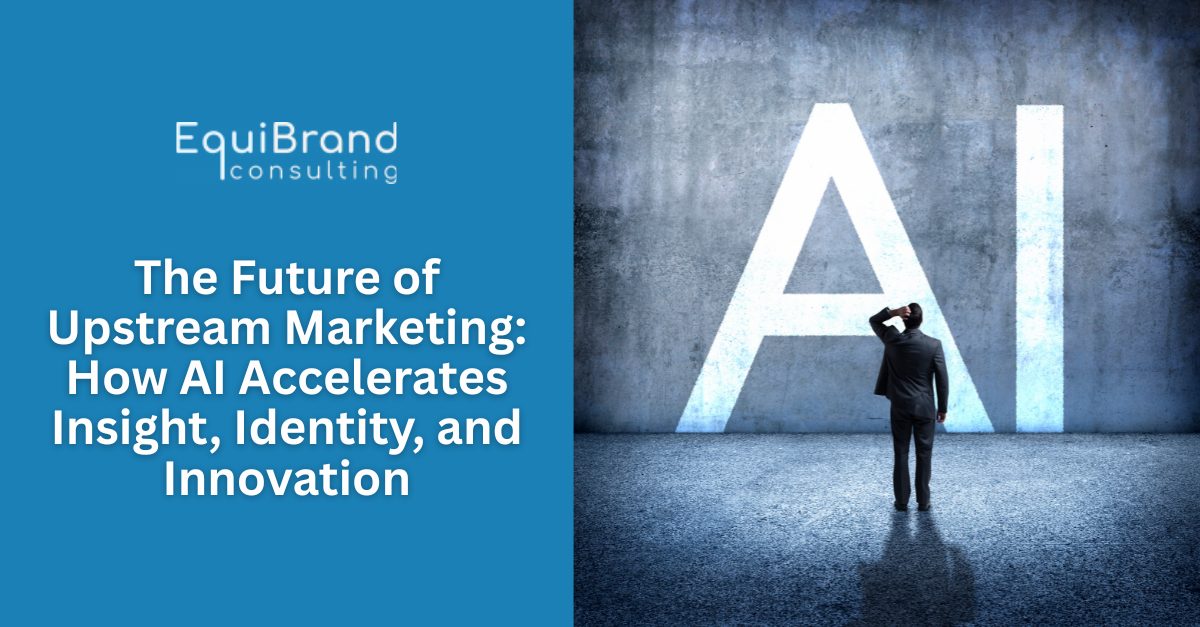AI isn’t just changing how marketers execute — it’s transforming how they think, plan, and innovate from the very start.
Everyone’s talking about AI right now. Most of the noise focuses on automation or content creation — ways to crank out emails or ads faster. That’s fine for downstream marketing. But what about upstream — the strategy side, where growth starts?
That’s where AI’s real potential lies.
Upstream marketing is about finding new ways to grow — by understanding customers more deeply, defining what your brand stands for, and shaping innovations that meet emerging needs. Chapter 8 of Upstream Marketing lays out a seven-step process for doing exactly that. If we apply today’s AI capabilities across those same steps, we can speed up discovery, sharpen strategy, and make innovation less guesswork, more learning.
Let’s walk through it.
1. Clarify Your Purpose and Priorities
Before any technology comes into play, companies need clarity: Where do we want to grow, and why?
AI can help leaders answer that faster by scanning massive amounts of data — industry reports, trend signals, social chatter — and highlighting the biggest opportunity spaces. Instead of weeks of manual research, you can get an AI-summarized view of where demand is shifting, what customers are talking about, and which competitors are moving first.
It’s not about letting the algorithm decide your strategy. It’s about using AI to make sure you’re aiming in the right direction.
2. Frame the Market Landscape
Once you know your purpose, you need to define the market. Who are you serving, and where do you play?
AI tools can cluster customer data in new ways — uncovering segments based on shared motivations or emotions, not just demographics. Natural-language models can read thousands of reviews and find hidden patterns: unmet needs, recurring frustrations, emerging expectations.
You still decide which segments matter most. AI just gives you a better map.
3. Develop Deep Insight
This is the heart of upstream marketing: understanding the “why” behind behavior.
AI can go deeper than traditional analysis by detecting themes humans might miss. Imagine uploading dozens of interview transcripts or open-ended survey responses and having an AI model highlight the emotional language people use around your category. You can then explore the tensions and desires driving those words.
Insight still requires interpretation and empathy — that’s your job. But AI can get you to those aha moments much faster.
4. Shape the Value Proposition
Now comes the creative synthesis: connecting what customers need with what your brand can uniquely deliver.
AI can act like a creative partner here. You can feed it your key insights, customer pain points, and product strengths — then ask for multiple ways to express the value proposition. It’s like having a brainstorm partner who never gets tired.
From there, you can refine, test, and humanize. The best ideas still come from people — AI just helps you explore the edges more efficiently.
5. Build and Extend the Brand
A clear value proposition needs a clear brand architecture. Many organizations struggle here: too many brands, unclear relationships, confusing names.
AI can analyze how customers actually talk about your products and recommend simpler structures. It can show which brands feel similar, where equity overlaps, and where whitespace exists.
Think of it as turning your brand portfolio into a customer-friendly system, grounded in real data rather than internal org charts.
6. Test and Learn
One of the biggest AI advantages is speed. You can test new ideas, messages, and visuals almost instantly.
AI image tools can mock up prototypes before a designer ever touches them. Large-language models can simulate early customer feedback or sentiment, helping you spot which concepts resonate before you launch expensive research.
It’s not a replacement for real testing — it’s a rehearsal. You fail faster, learn faster, and improve before it costs you.
7. Launch and Adapt
Finally, once you bring ideas to market, AI becomes your ongoing learning engine.
AI dashboards can monitor customer reactions in real time — what people are saying, how they’re behaving, where interest is growing or fading. That creates a feedback loop: insight flows back upstream, helping you adjust strategy quickly.
When Chapter 8 talks about upstream marketing as a cycle, not a checklist, this is what it means. AI makes that loop continuous.
Bringing It All Together
AI doesn’t replace upstream marketing — it enhances it. It doesn’t remove the need for judgment, intuition, or creativity — it amplifies them.
When used across the 7-Step Approach, AI helps you:
- See opportunity sooner (through better data synthesis)
- Understand customers deeper (through emotional and behavioral insight)
- Create smarter strategies (through faster iteration)
- Keep learning after launch (through real-time feedback loops)
That’s the future of upstream marketing: not man or machine, but man with machine — thinking together.
Wondering How AI Fits Into Your Upstream Journey?
Chapter 8 of Upstream Marketing outlines a clear roadmap — seven steps for turning insight and innovation into real results.
At EquiBrand Consulting, we help teams apply that roadmap in the AI era, blending timeless strategy with modern intelligence.
To learn more, contact us for a conversation, or read Chapter 8 of Upstream Marketing FREE to see how upstream thinking – and the principles behind AI in upstream marketing – can inspire your next phase of growth.




















Follow EquiBrand